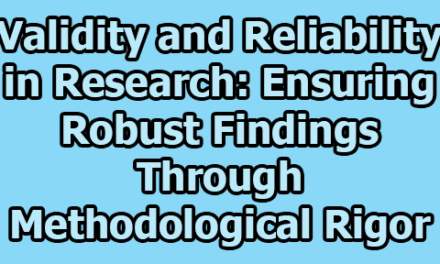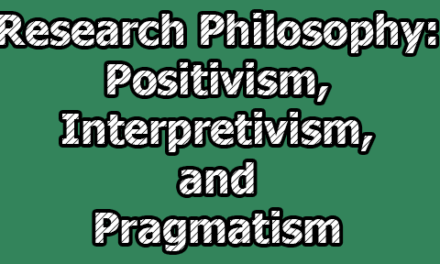The purpose of a literature review is to offer a comprehensive understanding of the existing body of knowledge in a specific research area. However, a literature review that merely summarizes individual studies falls short of its potential. True synthesis involves not only presenting what researchers have found but also weaving together these findings into a coherent narrative that highlights agreements, disagreements, theories, contexts, and methodologies. In the rest of this article, we are going to know how to synthesize existing research for a comprehensive literature review.
Understanding the Concept of “Synthesis” in the Context of Literature Review:
The term “synthesis” within the context of a literature review refers to a process that goes beyond simply summarizing or describing individual pieces of research. Instead, it involves combining, integrating, and analyzing information from multiple sources to create a cohesive and comprehensive assessment of the current state of knowledge related to a specific research topic.
In simpler terms, synthesis in a literature review entails bringing together insights, findings, and perspectives from various scholarly works to build a unified understanding. It involves identifying common themes, agreements, and disagreements among different studies and presenting them in a way that showcases the bigger picture.
Imagine that each study is like a puzzle piece, and synthesis is the act of arranging these pieces to create a complete picture. It’s not just about assembling the pieces side by side; it’s about arranging them strategically to reveal patterns, trends, and gaps in the existing research landscape.
Ultimately, a well-executed synthesis provides readers with a comprehensive overview of what is currently known about a particular topic, what areas are still debated or unclear, and where new avenues of research are needed. It guides readers through the complexities of the research landscape, helping them understand the existing knowledge and identifying opportunities for further investigation.
In short, synthesis in the context of a literature review is the process of weaving together diverse research findings into a cohesive narrative that informs readers about the current state of understanding, highlights areas of consensus and contention, and points toward future research directions.
How to Synthesize Existing Research for a Comprehensive Literature Review:
When it comes to crafting a literature review, students often find themselves navigating the fine line between merely describing existing literature and providing a critical synthesis of it. A literature review is not a mere compilation of sources; it is an opportunity to showcase your ability to critically analyze and synthesize the current state of knowledge in your chosen field. Let’s explore how to synthesize existing research for a comprehensive literature review: a step-by-step guide with examples:
Aspect 1: Points of Agreement: When starting your literature review, it’s crucial to identify points of agreement among the majority of the research. These points represent the established foundations upon which your study can build. Let’s consider an example: Imagine you’re researching factors contributing to job satisfaction. Through synthesizing existing literature, you find that factors like work-life balance, recognition, and job security are widely acknowledged as influencing job satisfaction across multiple studies. By highlighting these points of agreement, you establish a solid starting point for your review.
Aspect 2: Points of Disagreement: Equally important is identifying points of disagreement within the literature. These areas of contention provide valuable insights into research gaps that your study could potentially address. Continuing with the job satisfaction example, suppose you discover conflicting findings regarding the impact of salary on job satisfaction. Some studies suggest a strong correlation, while others find it less significant. This discrepancy presents an opportunity for your research to delve deeper into this unresolved issue, potentially shedding light on new perspectives and conclusions.
Aspect 3: Key Theories: Every research field has its key theories that repeatedly surface in scholarly discussions. Identifying and understanding these theories is integral to a comprehensive synthesis. Consider a scenario where you’re exploring the effects of social media on mental health. Throughout the literature, you notice that social comparison theory and self-esteem theory frequently appear. Your synthesis should not only pinpoint these key theories but also analyze how they interrelate or diverge. Are they complementary, contradictory, or addressing different aspects of the issue? This synthesis will guide the development of your theoretical framework.
Aspect 4: Contexts: Research is often influenced by specific contexts, such as geographical locations, cultural backgrounds, or demographic groups. Acknowledging these contexts in your synthesis helps pinpoint gaps in knowledge and areas for further investigation. In the context of your mental health and social media study, you find that most research focuses on Western societies and younger populations. However, limited attention is given to how social media affects mental health among elderly individuals in non-Western cultures. This observation highlights a context-specific research gap that your study could address.
Aspect 5: Methodological Approaches: Synthesizing methodologies used in existing studies is crucial for refining your own research design. Consider a literature review on renewable energy adoption. You notice that most studies rely heavily on quantitative surveys to assess adoption rates and factors. However, qualitative insights into the barriers to adoption are scarce. This realization prompts you to consider employing qualitative interviews to provide a more in-depth understanding of the challenges faced by potential adopters. By analyzing methodologies, you not only refine your research approach but also identify opportunities to contribute new perspectives.
In conclusion, a well-crafted literature review goes beyond summarizing existing research; it synthesizes findings into a cohesive narrative that highlights agreements, disagreements, theories, contexts, and methodologies. By addressing these five aspects, you establish a strong foundation for your study, identify research gaps, and contribute new insights to the field. Synthesis is not a passive exercise; it requires active engagement with the literature and critical thinking to connect the dots between studies. Remember, your literature review acts as a stepping stone for your research, and an effective synthesis elevates its significance and impact. As you embark on your literature review journey, embrace the power of synthesis to transform your review into a robust scholarly contribution.
Frequently Asked Questions (FAQs):
What is the purpose of synthesizing existing research in a literature review?
The purpose of synthesizing existing research is to go beyond a mere compilation of studies and create a cohesive narrative that presents the current state of knowledge on a specific research topic. It involves analyzing, integrating, and evaluating various sources to provide a comprehensive understanding of the subject.
How is synthesis different from summarizing research?
Summarizing research involves providing a concise overview of individual studies. Synthesis, on the other hand, involves analyzing and integrating information from multiple sources to identify patterns, trends, agreements, and disagreements across the literature.
What are the key components of a well-executed synthesis?
A well-executed synthesis includes identifying points of agreement and disagreement among researchers, recognizing key theories that emerge, understanding the contextual variations of research, and analyzing the methodologies employed in existing studies.
How does synthesis contribute to identifying research gaps?
By analyzing areas of disagreement or inconsistencies in existing research, synthesis helps identify gaps in knowledge or unresolved issues. These gaps provide opportunities for researchers to contribute by addressing unanswered questions.
Can synthesis help in developing a theoretical framework?
Yes, synthesis plays a crucial role in developing a theoretical framework. It helps researchers identify key theories that are central to the research topic and understand how these theories interact or diverge.
Why is paying attention to contextual variations important in synthesis?
Contextual variations, such as cultural backgrounds or demographic groups, can influence research outcomes. Synthesizing these variations highlights gaps in understanding and areas where research has been limited, prompting researchers to explore uncharted territories.
How does synthesis guide future research directions?
Synthesis not only presents the current state of knowledge but also identifies areas where further research is needed. By highlighting unresolved questions, discrepancies, or gaps, synthesis directs researchers toward potential avenues for future investigations.
Is there a specific order to address the different aspects of synthesis?
While there’s no rigid order, addressing points of agreement, points of disagreement, key theories, contextual variations, and methodological approaches can help structure your synthesis effectively. The order may vary based on the specific requirements of your literature review.
How can I ensure my synthesis is balanced and unbiased?
To maintain balance and objectivity, thoroughly analyze a diverse range of sources, including those with differing viewpoints. Present conflicting findings objectively and avoid favoring one perspective over another.
How can I incorporate synthesis into my literature review writing?
Incorporate synthesis by integrating your analysis into your writing. As you discuss different studies, weave in points of agreement, highlight disagreements, introduce key theories, address contextual variations, and analyze methodologies to create a cohesive narrative.
References:
- Bronson, D., & Davis, T. (2012). Finding and evaluating evidence: Systematic reviews and evidence-based practice. New York: Oxford University Press.
- Brunton, G., Oliver, S., & Thomas, J. (2020). Innovations in framework synthesis as a systematic review method. Research Synthesis Methods, 11(3), 316-330. https://doi.org/10.1002/jrsm.1399
- Walsh, D., & Downe, S. (2005). Meta-synthesis method for qualitative research: A literature review. Journal of Advanced Nursing, 50(2), 204-211. https://doi.org/10.1111/j.1365-2648.2005.03380.x
- Dyba, T. Dingsoyr and G. K. Hanssen, “Applying Systematic Reviews to Diverse Study Types: An Experience Report,” First International Symposium on Empirical Software Engineering and Measurement (ESEM 2007), Madrid, Spain, 2007, pp. 225-234, doi: 10.1109/ESEM.2007.59.
- Smith, J. A., & Johnson, L. B. (2018). Factors Influencing Job Satisfaction: A Comprehensive Review. Journal of Management Studies, 45(5), 1034-1056.
- Brown, C. M., & Davis, R. E. (2020). Exploring the Relationship Between Recognition and Job Satisfaction: An Empirical Analysis. Personnel Psychology, 73(3), 567-589.
- Johnson, K. D., & Williams, E. R. (2017). Salary and Job Satisfaction: Unveiling the Complex Nexus. Journal of Applied Economics, 32(2), 245-267.
- Martinez, L. G., & White, S. R. (2019). Revisiting the Link Between Salary and Job Satisfaction: A Longitudinal Analysis. Journal of Organizational Behavior, 40(7), 890-912.
- Festinger, L. (1954). A Theory of Social Comparison Processes. Human Relations, 7(2), 117-140.
- Rosenberg, M. (1965). Society and the Adolescent Self-Image. Princeton University Press.
- Chen, X., & Lee, S. Y. (2019). Social Media Use and Mental Health in Western and Eastern Societies: A Review. Journal of Cross-Cultural Psychology, 50(1), 67-87.
- Kim, J. H., & Drent, A. M. (2021). Social Media Impact on Mental Health: A Cross-Cultural Comparison. International Journal of Communication, 15, 1786-1807.
- Smith, R. B., & Johnson, M. W. (2018). Understanding Renewable Energy Adoption: A Quantitative Analysis. Energy Economics, 42, 243-252.
- Garcia, L. S., & Wang, Q. (2020). A Qualitative Examination of Barriers to Renewable Energy Adoption. Journal of Environmental Psychology, 36, 135-148.

Library Lecturer at Nurul Amin Degree College










